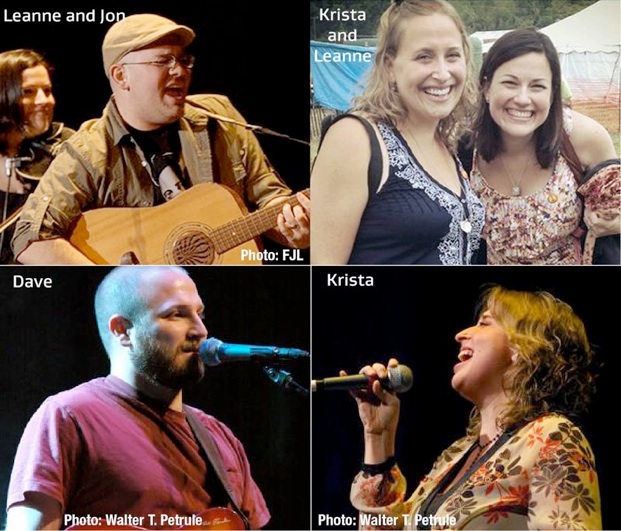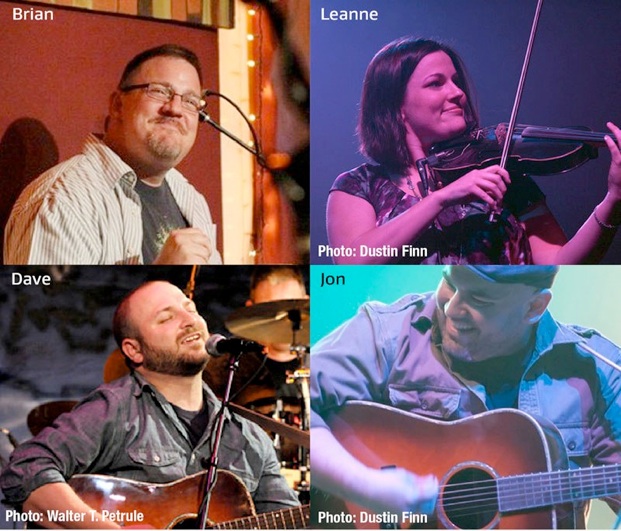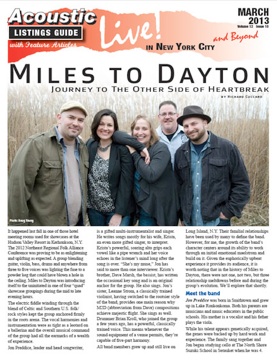Miles to Dayton
Journey to The Other Side of Heartbreak
By Richard Cuccaro
It happened last fall in one of those hotel meeting rooms used for showcases at the Hudson Valley Resort in Kerhonkson, N.Y. The 2012 Northeast Regional Folk Alliance Conference was proving to be as enlightening and uplifting as expected. A group blending guitar, violin, bass, drums and anywhere from three to five voices was lighting the fuse to a powder keg that could have blown a hole in the ceiling. Miles to Dayton was introducing itself to the uninitiated in one of four “quad” showcase groupings during the mid to late evening hours.
The electric fiddle winding through the blend of Celtic and Southern U.S. folk/rock styles kept the group anchored firmly in the roots arena. The vocal harmonies and instrumentation were as tight as a leotard on a ballerina and the overall musical command of the group had all the earmarks of a wealth of experience.
Jon Preddice, leader and head songwriter, is a gifted multi-instrumentalist and singer. He writes songs mostly for his wife, Krista, an even more gifted singer, to interpret. Krista’s powerful, soaring alto grips each vowel like a pipe wrench and her voice echoes in the listener’s mind long after the song is over. “She’s my muse,” Jon has said to more than one interviewer. Krista’s brother, Dave March, the bassist, has written the occasional key song and is an original anchor for the group. He also sings. Jon’s sister, Leanne Strom, a classically trained violinist, having switched to the rootsier style of the band, provides one main reason why M2D (abbreviation from Dave) compositions achieve majestic flight. She sings as well. Drummer Brian Kroll, who joined the group a few years ago, has a powerful, classically trained voice. This means whenever the sound equipment of a venue permits, they’re capable of five-part harmony.
All band members grew up and still live on Long Island, N.Y. Their familial relationships have been used by many to define the band. However, for me, the growth of the band’s character centers around its ability to work through an initial emotional maelstrom and build on it. Given the euphorically upbeat experience it provides its audience, it is worth noting that in the history of Miles to Dayton, there were not one, not two, but three relationship meltdowns before and during the group’s evolution. We’ll explore that shortly.
Meet the band

Jon Preddice was born in Smithtown and grew up in Lake Ronkonkoma. Both his parents are musicians and music educators in the public schools. His mother is a vocalist and his father plays the viola.
While his talent appears genetically acquired, the genes were backed up by hard work and experience. The family sang together and Jon began studying cello at The North Shore Suzuki School in Setauket when he was 4. He studied the trumpet in public school and was in the school band, the church choir and youth orchestras. A passion for trumpet led to an advanced study in jazz later on. Although Jon is well-rounded, music was always number one in the household while he was growing up. He’s been classically trained but still remembers the feeling of discovering different styles of music like jazz, rock, folk and funk. He had a band in high school called Feed the Cat. In college, at the University of Miami, he studied the cello and trumpet, sang in the jazz vocal ensemble and had his own band called Soma.
Jon fell in love with a fellow student he met at the University of Miami. He followed her to the Midwest, where she had accepted a job offer. The relationship fell apart after a year. Brokenhearted, Jon returned home to Long Island. The first step toward Miles to Dayton was taken.
Dave March was born in Huntington in 1976, and he and his sister Krista grew up in Centereach, where they and Jon all attended Centereach High School. However, Dave was four years ahead of Krista and three ahead of Jon, so the two boys knew who each other was, but were “like ships passing in the night,” according to Jon.
The March family had its own musical heritage to pass along. Dave’s grandfather owned a music store where he taught accordion to Dave’s mother and all of her siblings. He would later become a piano tuner. Dave remembers that his grandfather “would play accordion for us as kids, and as we got older influenced us to play music.”
The March parents played a lot of records for the kids. Dad leaned toward Styx and Led Zeppelin, while Mom tilted in the direction of Neil Diamond and Barbra Streisand. The floodgates opened for Dave and Krista one New Year’s Eve when their mother played her entire Beatles collection. “There was no turning back after that,” as far as Dave was concerned. He’d just have to play music.
Dave started playing guitar in 10th grade. He took a few lessons and jammed with a neighbor who played guitar and picked it up pretty quickly.
When Dave was about 16, he started playing gigs in an acoustic duo with a friend. Crosby, Stills, Nash and Young’s album Four Way Street had made an impact and would set the structure for the musical style he would prefer from that point on.
There really weren’t many places an acoustic duo could play during his high school years. Most places were bars that were still promoting a lot of the dying glam rock scene of the late ’80s and early ’90s, but nevertheless, they managed to play a few opening slots. Although he dabbled in punk and hard-core rock, he continued to return to the acoustic/folk genre.
As open mics began to pop up around the area in new coffee shops and wine bars on Long Island, he and Krista began performing together. They started a group with her then-boyfriend, called Sleeping Genius which flourished from playing open mics and had a similar folk rock sound to M2D.
Dave states that while he cannot read music, he’s developed a really good ear and his storehouse of musical ability has come from years of playing with other musicians.
Krista March (now Preddice) conveys a slightly different viewpoint from her brother. For her, the big influence was her grandmother, who, when younger, had sung in a large traveling choral group called The Sweet Adelines. This was a huge inspiration for Krista. Another was her mother, who taught piano.
For Krista, the first non-family influence came from the Broadway play (and subsequent movie) “Annie.” Krista wanted to be Annie. She learned all the songs and would dance to them. An innate performer, she says she needed no prodding to sing for the family. “Someone would always have to introduce me and I would come out of the woodwork somewhere.”
The road to becoming a performer, however, was not without some delays. Throughout grade school she’d sing her part, but wouldn’t make an effort to stand out from the group. Then Krista came out of her shell. As part of a select group in high school chorus, she took more solos. She also joined a youth group and sang in its choir. The chorus provided her only instruction in singing. Her lofty powerhouse alto didn’t need any more than that. Jon and Krista knew each other well in high school (he might not have been aware of it, but she had a crush on him). She was in chorus with Jon and was in a couple of plays that he was in.
Apart from”Annie,” Krista liked The Beatles from her early years. Later, she started listening to female singers. Sarah McLachlan, The Cranberries and Natalie Merchant became her favorites.
As always, one thing leads to another. Krista performed in a variety show in her senior year of high school. Dave and her then-boyfriend backed her up on bass and guitar, respectively. They enjoyed it so much that they decided to become a group. Sleeping Genius lasted five years. During that time, Krista went to college to earn a teaching degree. When the relationship with her boyfriend collapsed, the group broke up and she went into a tailspin and didn’t do music for about a year. Although Dave stayed active, he missed making music with his sister.
At this point, M2D was about a year from its inception. Leanne and Brian’s entry into our story comes a bit further in.
The band is born

About the time Jon was returning from Chicago to nurse his wounds, Dave was hosting an open mic at a local Starbucks. Krista, coming out of a yearlong post-breakup funk, was working as a barista at the same Starbucks. Krista ran into Jon and suggested that he come down and play at Dave’s open mic. Jon, Krista and Dave began to hang out together and began playing together fairly quickly.
Jon and Krista began connecting with each other on a musical and personal level. Jon was caught in an emotional snare and writing songs to express his loss. The songs worked for Krista as well, helping to heal both of them. Although Jon and Krista were becoming a couple, their progress didn’t exactly dovetail. Krista was a year further into her healing while Jon had some catching up to do.
They spent another year riding an emotional rollercoaster while they wrote and recorded songs for the band’s first album, A Long Way Back (2005). There are songs about Jon and Krista getting together and breaking up all through that album. The title aptly suggests that time had to elapse before they could understand the process they were going through. For instance, “Green Light Go” was a positive song about both Jon and Krista, attempting to will them to “take that step.” Krista co-wrote “Therapy” with Jon, essentially telling him to get over his ambivalence in letting go of his ex-girlfriend and accepting her as his true soul mate. The fact that it was developed and presented on the album says a lot about their seriousness of intent, both musically and personally. One exception to the general theme is “Dayton,” a song for Jon’s grandfather. The band’s name refers to living life to its fullest – going the miles – until being reunited with loved ones who’ve passed on.
Somewhere during the evolution of M2D, Dave’s busy life in music, playing bass for M2D and other groups, provoked insecurity in his girlfriend with whom he’d become serious. An inevitable breakup followed, leaving Dave with his own grieving process.
After the first album was released, violinist Leanne Strom, Jon’s married sister, came into the group. At the time I was interviewing the band, Leanne was busy having a baby and was unable to participate. Leanne had studied at the same Suzuki school as Jon and had played with him all her life. She knew what Jon was looking for and it didn’t take long to get on the same wavelength.
Leanne’s contribution to the second album, Rise (2007), is significant. The mood is substantially more upbeat and Leanne’s electric violin plays a big role.
Brian Kroll entered the picture right after the release of Rise, while M2D was showcasing the album. The band was playing a street fair in Sayville, where Brian was living. He heard them and was very impressed – “blown away,” in fact. Original drummer Robert Caniglia was on that tour. Two years later, Brian made a special trip to see the band and, lo and behold, they were playing without a drummer. Robert had left the group. Brian reintroduced himself, and then sent a follow-up email to Jon, pitching himself for the drummer’s slot. When Brian showed up to a subsequent gig, he introduced himself to Dave. Not realizing what was transpiring, the normally freewheeling Dave apprehensively asked Jon “Who is this guy?” In a role reversal, the normally cautious Jon answered, “He’s our new drummer. I already hired him.”
Brian, it turns out, was more than ready to fit in with M2D. As a kid growing up in West Hempstead, he obsessively drummed on everything – pots, boxes, whatever. His sisters’ record collection planted the seed and today he can’t remember a time when he didn’t want to be a musician. He grew up on progressive or “prog” rock such as Yes and Genesis. His taste would later run to Phish, Rusted Root, Dave Matthews and, in college, funk acts.
School protocol demanded that Brian had to start by learning band instruments, so he played bassoon and upright bass in fourth grade. It turned out, however, that Brian was the best drummer in the school. When he was in sixth grade, he got a drum set at home and took lessons. By seventh grade, he was the drummer for the school band.
Brian had his own band in high school, and then received classical training as a voice major at Hofstra University. He played drums all through college and gigged in a progressive rock band and a cover band. A strong singer, he performed in local regional theater playhouses. As a member of the Actors’ Equity Association, he was “officially” a professional. Also, while working as a band member through the Long Island-based Omnipop Agency, he played in highly accomplished cover bands for clubs on Long Island, in upstate ski lodges and on the Jersey Shore. After Brian joined M2D, the first show was in Huntington and everything clicked. Two months later he was a full-fledged member. Brian’s musical tastes now run closer to Iron & Wine, Ray LaMontagne and Mumford & Sons.
The Music
By the time this author caught up to Miles to Dayton, it had released its third album, Pass It On (2011). The progression from one album to the next is readily evident to even the most casual listener. The band radiated more power with each release.
Whereas A Long Way Back had a more pensive, ethereal feel overall, Rise kicks off immediately with “Eyes Light” with its refrain my heart sings, revealing a huge uptick in both mood and energy. Likewise, the title track entreats a rise from the ashes.
“Flying” has special meaning. In the middle of a big show at the Patchogue Theatre in 2008, Jon fed his cello through a loop and, over his instrumental, proposed to Krista in front of 700 to 800 people. On the recorded track, we hear Krista singing, In your heart, you will find a piece of me, a symphony… Krista later walked down the aisle to the accompaniment of Jon’s cello solo from that song. Hollywood couldn’t have done it any better.
Pass It On shows the band reaching an even higher level of intensity. Brian’s drumming, Leanne’s bowing, the singers’ harmonies all reach a new level. The songs’ themes and their execution have an exhilarating uplift. The title track sums up the album’s purpose nicely: All the loving in the world won’t mean a thing unless you learn how to sing and share it … and pass it on.
Brian’s passionate summation from our interview captures his feelings about the group and the audiences’ as well: “The non-common elements – the differently trained musicians – fit together in this band and something magical happens when we get together in a room.” We agree. We’ll be watching as they scale new heights.
Website: milestodayton.net
Upcoming performances include:
Mar 16 7pm Urban H2O Beczak Environmental Education Center,
Yonkers, NY
Apr 13 8:30pm Folk 2 Funk Festival, Long Beach Public Library,
Long Beach, NY
Jun 7 7:30pm Garden Stage: M2D and Robert Bruey,
Unitarian Universalist Congregation of Central Nassau,
Garden City, NY


